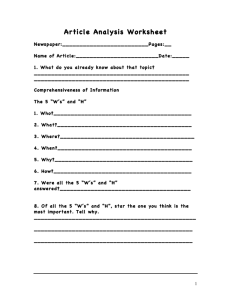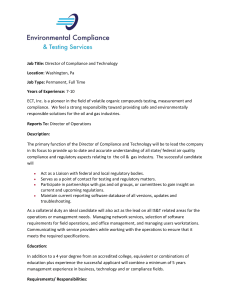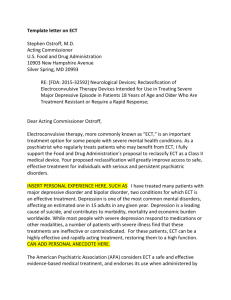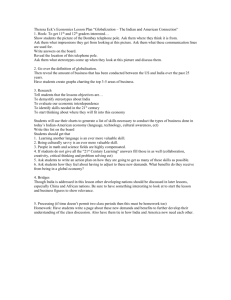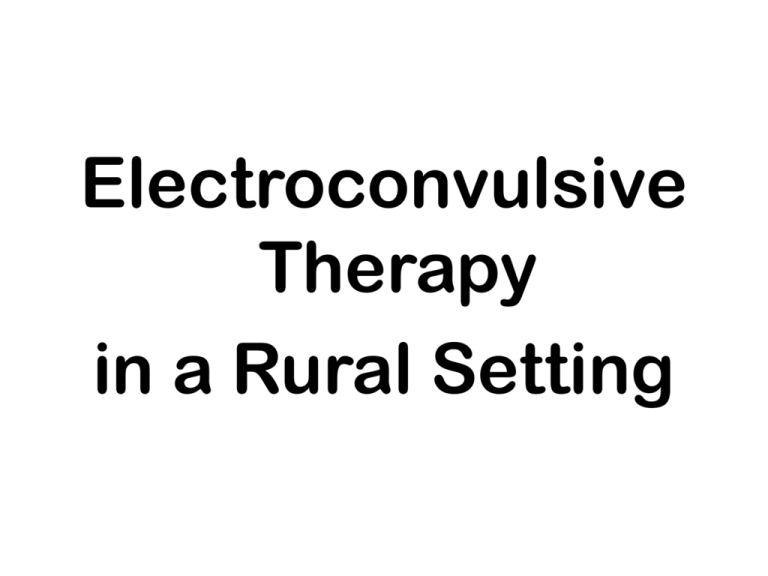
Electroconvulsive
Therapy
in a Rural Setting
George R Martin, MD
Staff Physician
Department of Psychiatry
James A Quillen VA Medical Center
Mountain Home, Tennessee
Associate Professor, Psychiatry
James A Quillen School of Medicine
East Tennessee State University
Johnson City, Tennessee
Six Questions
(1) What it is not
(2) What it is
(3) How it is done
(4) For whom does it work
(5) For whom does it not work
(6) Why is it worth supporting in this region
What it is not
What it is
Part 1: How it began
Ladislas J. Meduna
Ladislas J. Meduna (1896–1964)
• Hungary until 1938 then Loyola University &
Illinois Psychiatric Institute
• Noted that epileptics and schizophrenics have
differing ratios of glial cells at autopsy
• Could induced seizures heal schizophrenia?
• Camphor then metrazol. Five treatments
• 29 initial cases, 10 “cured” and 3 improved
• 10 of first set had catatonia
•
•
•
•
Ugo Cerletti 1877- 1963
Designed winter camouflage uniforms for
Italian Army
Designed delayed fuses for artillery shells
1935 Chair, Department of Neurological and
Mental Diseases at the University of Rome
Iatrogenic malaria “cured” general paresis.
Assigned to pick up dinner from local butcher,
but butcher out of the specified cut of meat.
Butcher shop to slaughter house
– Shocked pigs
– stunned and docile
– easy to slaughter
Would it work on people?
Tried dogs first, lots of cardiac deaths
Eventually settled on bilateral head electrodes
Lucio Bini (1908 – 1964)
•
•
•
•
•
Italian psychiatrist
Colleague of Cerletti
Let’s try it on people with mental illness
“meek and mild,” not looking for cure
Several treatments led to remission lasting for
many months.
• Initial patients:
– Obsessional,
– schizophrenia,
– manic-depressive
Mortality rates
Schizophrenia’s morality rate in 1930’s was 20%
Mortality of Cerletti’s shocks was 10%
Meta-analyses of published data from 1969 –
1996:all-cause SMRs of 1.51 and 1.57 (UK)
1997 excess mortality rates suicide (28%),
accidents (12%) and natural causes (60%).
Schizophrenia life expectancy UK < 10-15 years
US < 15 -23 years
1977-1990 Harvard University
the mortality rate in subjects within 15 years
after first hospital admission:
major depression without psychosis 20%
major depression with psychosis 41%
Current US: Bipolar reduces life expectancy by
9.3 years.
What it is
Part 2: The Preliminaries
1. Patient selection
2. Pre treatment workup
Patients for whom ECT should be a
serious option
“Before you go home”
Psychotic Depression
• Nihilistic delusions
• Body rotting from the inside
Catatonia (Schizophrenia, catatonic type)
• Stuporous
• Excited
Good ECT candidates
Depression:
• Relenting and unresponsive
• Usual medications contraindicated
• Actively suicidal
• malnourished/electrolyte imbalance
• Prolonged Manic episode (neurodegenerative)
Good ECT candidates
Psychosis
• Schizophrenia, unrelenting and unresponsive
• Usual medications contraindicated
• Actively suicidal
• Affective component
Pregnancy
Largest series is 339 cases (1941 – 1992)
Majority treated for depression
At least partial remission reported in 78%
There were 20 maternal complications reported
and 18 were likely related to ECT.
Four cases of premature labor (1.3%)
In all cases, the clinician determined that the
premature labor was not related to the ECT.
Miscarriage rate for women receiving ECT
during pregnancy (1.6%) not significantly higher
than the rate of miscarriage in the general
population.
Unusual and “desperate” situations
Parkinson’s Disease
•
•
•
•
Depression
Abnormal Movements
Psychosis
Dementia
De la Tourette’s
OCD
Delusional Disorder
Epilepsy
PTSD
Neuroleptic Malignant Syndrome
Poor candidates
Predominantly personality disorder
Unstable logistics/unreliable
Somatic focused
Anesthesia risks
Drug/alcohol addicts due to anesthesia risks
Militant family member
Pre treatment workup
•
•
•
•
•
•
No “absolute” contraindications
Unstable arrhythmias with risk of asystole
Recent MI and unstable cardiac function
Space occupying CNS entity especially low
Recent hemorrhagic CVA or unstable
aneurysm
Retinal detachment
Pheochromocytoma
Pre-treatment workup
Vital Sign recordings
Routine pre-anesthesia labs
Spine films
Imaging of the head
EKG
What it is
Part 3: The treatment itself
The Evolution of the procedure
Early 1940’s introduced to US and UK
“Unmodified” sine wave (AC) current, no meds
Tried curare as paralytic agent
Succinyl choline 1951
Late 1950’s general anesthesia
1976 Data shows pulsed DC current superior to
alternating current (Blatchley)
AC vs DC pulsed current
Variation of pulse parameters
Recovery room or outpatient surgery
NPO
IV
Anesthesia monitoring
• Cardiac
• Pulmonary
• BP
• External Ventilation
Driver and not home alone
Caffeine (IV)
Romazicon (Flumazenil)
Short acting anesthetic
• methohexital (Brevital)
• propofol (Diprivan)
• Ketamine
Glycopyrrolate (Robinul) peripheral
antimuscurinic
Paralytic agent: Succinyl Choline
Pre-existing Medications during ECT
Anticonvulsants and barbiturates
• Reduce effectiveness of seizures
• If used for epilepsy, replace with benzos
• If used as a “mood stabilizer” can be eliminated
during ECT
Benzodiazepines
• Almost universal
• Neutralized by flumazenil (Romazicon)
Lithium controversial
(1) thought to increase risks of delirium and/or
(2) Perhaps prolongs neuromuscular effect of
succinyl choline
Psych Meds during ECT
Anti psychotics.
ECT + trifluoroperazine
• BPRS 61 % decrease at 6 weeks
• An additional 15 % at 20 weeks
Sham ECT and Trifluoroperazine
• BPRS 28% decrease at 6 weeks
• an additional 25% at 20 weeks
Antidepressants during ECT
• Studies are meager and not useful
• U of Pittsburgh: All depressed patients start
Lithium and Nortriptyline for last week of Tx
• Lag time to effective response to antidepressants is several weeks.
• EEG Monitoring.
EEG monitoring
Single line tracing, not 21
Determines length and architecture of seizure
Determines that it stopped
Multiple monitored, not additionally effective
Electrode placement
Non-dominant Unilateral
– Recommended in 1978
– Hope to reduce memory loss
– More “missed” seizures
– Used at initial treatment and continue if effective
Bilateral
Almost universal in US and UK
Some memory loss, less now with pulsed current
Seizure Architecture on EEG
1.
2.
3.
4.
Recruiting
Full seizure: Delta waves
Suppression
Quiet/Recovery
Treatment Response
Treatments three times per week
See initial progress after 3-6 treatments
Progress should be steady, but will plateau
Go two more treatments and stop
Common 9-12, 24 maximum
Maintenance reduces relapse
Controversies
Memory loss
Safety
Effectiveness
Anti-psychiatry
Memory Loss
•
•
•
•
•
•
•
Retrograde
Usually short term
“autobiographical”
Much less with newer technology
Some patients claim longer, larger loss
Usually resolves within weeks to months
“Can’t concentrate, can’t remember” are
standard complaints of severely depressed.
Glenda MacQueen, MD, FRCPC, PhD Professor
University of Calgary (2007) demonstrated
some cognitive deficits after ECT.
“However, it is… unlikely that such findings,
even if confirmed [by others], would
significantly change the risk–benefit ratio of
this notably effective treatment.”
Harold Sacheim, PhD, Columbia University
Review of old studies
• Memory loss is real
• Significant with 50’s technology
New study 347 patients (2007)
• Minimal loss with current type of treatments
• Unilateral is no protection
• No control group
Safety
Denmark 25 year study, ECT patients’ death
rate no different than general population
UK NHS 2011 death rate published as 4 or 5 in
100,000 (not clear if patients or treatments)
Sweden death rate from appendectomy on
non-perforated appendicitis was 56 in 73,326
cases, or 76/100,000
Efficacy
Daniel Pagnin, M.D., M.Sc.; Valéria de Queiroz,
M.D., M.Sc.; Stefano Pini, M.D.; Giovanni
Battista Cassano, M.D.
Efficacy of ECT in Depression: A Meta-Analytic
Review
University of Pisa, Italy J ECT 2004; 20:13—20
Reviewed Randomized and non Randomized
Efficacy
Randomized
• Predermined criteria of “success”
• Decision on medication doses and length of
treatment time
Non randomized
Ethics of “sham” ECT and anesthesia
Cannot do double blind cross over method
Randomized
The response criteria were defined as a
(1) reduction of at least 50% from baseline to end
point on the Hamilton Scale for Depression
(HAM-D), or
(2) HAM-D score of 10 or less at the end point, or
(3) clinical judgment of "recovered" or "marked
improved”
From: Efficacy of ECT in Depression: A Meta-Analytic Review
Date of download:
2/20/2012
Copyright © American Psychiatric Association. All
rights reserved.
Non Randomized
Lancet. 2003 Mar 8;361(9360):799-808.
Efficacy and safety of electroconvulsive therapy
in depressive disorders: a systematic review
and meta-analysis.
UK ECT Review Group.
• ECT was significantly more effective than
simulated ECT (six trials, 256 patients,
standardized effect size [SES] -0.91, 95% CI 1.27 to -0.54).
• Treatment with ECT was significantly more
effective than pharmacotherapy (18 trials,
1144 participants, SES -0.80, 95% CI -1.29 to 0.29).
• Bilateral ECT was more effective than unipolar
ECT (22 trials, 1408 participants, SES -0.32,
95% CI -0.46 to -0.19).
Why is it worth supporting
• Works for some patients when nothing else
does
• Works for some patients who cannot undergo
other treatments
• Works in pregnancy
• Requires special training and credentialling
• Requires a team: psychiatry, anesthesia,
nursing and administration
• Team is easier to sustain than to build from
scratch
• Need is growing and start from scratch only
alternative
• 2009 did 50 treatments per month,
• 2012 have 65 slots per month still not enough
http://www.youtube.com/watch?v=RFxVA2qG47M
http://www.youtube.com/watch?v=Y5LIVAaYNrQ
• http://www.youtube.com/watch?v=QjpmYSo
ApC0&feature=related
• http://www.youtube.com/watch?v=ZjFF81ikQ
Jc&feature=related
• Hope you will see it, be able to say “yes” to
someone who asks about it.

